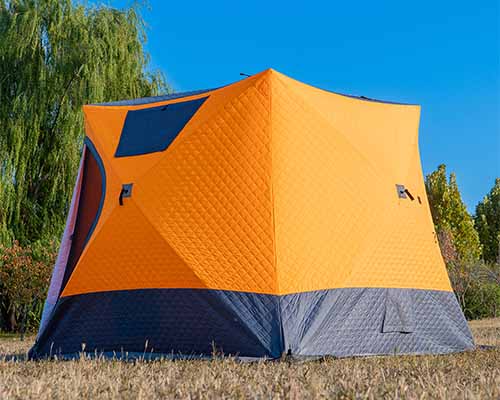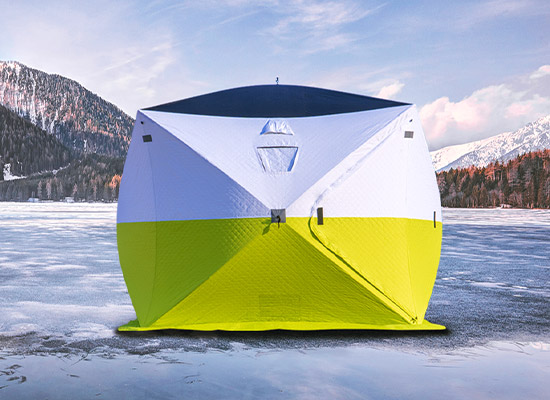Table of Contents
Introduction
Picture this: you’re nestled in your sleeping bag, the world outside is a silent, frozen wonderland, and a gentle breeze whispers against your shelter. This is the magic of winter camping. But that same breeze can quickly turn into a howling gale, and that gentle snow into a blinding blizzard. Your entire safety and comfort hinge on one critical piece of gear: your winter tent.
Unlike its three-season cousin, a true winter tent is your fortress against the elements. It’s the difference between a story of epic adventure and a fight for survival. This guide isn’t just a list of features; it’s a deep dive into the why and how, drawing on real-world experience and engineering to help you make the most informed decision. Let’s get you equipped.
Winter Tent vs. Three-Season Tent: It’s More Than Just a Season

The most common mistake is thinking a sturdy three-season tent can handle a winter night. The core difference lies in their design philosophy. A three-season tent is built to provide ventilation and protect from rain and bugs. A 4-season tent or winter tent, however, is engineered for strength, stability, and heat retention.
Think of it this way:
- A three-season tent is a comfortable sunroom.
- A winter tent is a reinforced bunker.
The numbers don’t lie. According to a design analysis by the European Outdoor Conservation Association, winter tents are typically constructed with 20-30% more pole segments, creating a geodesic or semi-geodesic structure that can withstand multidirectional wind loads and snow accumulation that would collapse a standard dome.
The 6 Pillars of a Superior Winter Tent
When evaluating a winter camping tent, you need to become a mini-expert on these six critical areas.
1. Tent Structure: Your Geometric Shield
The shape of your tent is its first line of defense.
- Dome Tents: Excellent all-arounders for winter camping. Their curved surfaces shed wind well and offer good internal volume. Look for models with intersecting poles that create multiple crossing points for enhanced stability.
- Tunnel Tents: The champions of space-to-weight ratio and superior wind resistance when pitched correctly. They must be staked out securely, which can be a challenge on hard, frozen ground.
- Pyramid Tents (Mids): Lightweight and stormworthy, with a single central pole (or trekking pole) and steep walls that shed snow effectively. Their limitation can be limited headroom around the edges.
Our Verdict: For most adventurers starting out, a 4-season dome tent with at least 3 poles offers the best balance of strength, easy pitching, and forgiveness.
2. Durability & Weather Protection: The Fabric of Survival
This is where the specs matter.
- Hydrostatic Head (HH): This measures waterproofing. For a reliable winter tent, look for a rainfly with a rating of at least 3000 mm, with 5000 mm+ being ideal for heavy, wet snow.
- Poles: Say no to fiberglass. Aircraft-grade aluminum is the gold standard. It’s lighter, stronger, and far more resilient in freezing temperatures, where fiberglass becomes brittle and can snap.
- The Snow Skirt: This is a crucial winter tent feature many overlook. It’s a fabric flap around the tent’s base that you can bury with snow. This blocks wind from stealing warmth from under your tent and prevents spindrift (blowing snow) from entering the living space.
3. Ventilation & Condensation Management: The Invisible Battle
Here’s a fact many don’t realize: You are the primary source of moisture inside your tent. Each person exhales roughly a liter of water vapor into the air each night. When that vapor hits the cold flysheet, it turns to frost or water.
A good winter tent manages this through strategic ventilation. Look for:
- Adjustable Top Vents: These allow warm, moist air to escape.
- Mesh Panels (protected by the fly): These allow for airflow while keeping the elements out.
- A Double-Wall Design: The gap between the inner tent and the rainfly is essential for air circulation.
Pro Tip: Even in a blizzard, you should crack a vent. A dry, well-ventilated tent at 20°F (-6°C) is warmer than a damp, sealed one at 32°F (0°C).
4. Space & Weight: The Eternal Compromise
Winter camping requires more gear—bulkier sleeping bags, insulated pads, and a stove. The “2-person” winter tent you look at will comfortably fit one person and their gear.
- Vestibule Space: This is non-negotiable. A large vestibule gives you a “mudroom” to store packs, cook safely (with extreme ventilation!), and remove snowy boots without burying your sleeping area.
- Peak Height: A slightly taller peak height makes changing clothes and moving around less of a chore, especially on multi-day trips.
5. Ease of Setup: Because Fumbling in a Storm is Miserable
Practice setting up your new winter tent in your backyard before your trip. Color-coded poles and clips are a godsend when you’re doing this with numb fingers. Remember, in deep snow, you’ll need deadman anchors (using stuff sacks, skis, or trekking poles) instead of standard stakes.
Beyond the Tent: Essential Winter Camping Tips

Your winter tent is the core, but these practices are what make a trip successful.
- Site Selection: Choose a spot sheltered from the wind. In deep snow, stamp down a platform and let it set for an hour before pitching.
- Use a Footprint: Always use a groundsheet to protect the tent floor and add a slight R-value boost.
- Snow Anchors: If you forgot stakes, your ski poles, ice axes, or even stuff sacks filled with snow and buried make excellent anchors.
Your Next Step Towards Unforgettable Adventures
Choosing the right winter tent is the most critical decision you’ll make for your cold-weather adventures. It’s an investment in safety, comfort, and the confidence to experience the mountains in their most pristine and powerful state.
At Shandong Xingyue Camping Outdoor Products Co., Ltd., we don’t just sell tents; we engineer shelters for explorers. Our designs are born from a passion for the outdoors and a deep understanding of what it takes to thrive in extreme conditions.
Ready to find your winter sanctuary? Explore our rigorously tested collection of 4-season and expedition-ready winter tents. Browse Our Winter Tent Collection Now and turn your cold-weather dream into a plan.
FAQ
What is the main difference between a 4-season and a winter tent?
The terms are often used interchangeably. However, a “4-season tent” is a broad category that can handle mild winter conditions, while a dedicated “winter tent” or “expedition tent” is built for the harshest conditions, featuring stronger poles, more robust fabrics, and features like snow skirts.
Can I use a 4-season tent in summer?
Yes, but with a caveat. They are warmer and often have less mesh than three-season tents, which can make them feel stuffy on a warm summer night. They are, however, perfectly usable.
How much should I expect to spend on a quality winter tent?
A reliable 4-season tent is a significant investment. Expect to start in the mid-range for a basic model and go up from there for technical, expedition-grade shelters. It’s a purchase that, with proper care, will last for decades of adventures.
Is a single-wall or double-wall tent better for winter?
Double-wall tents are generally preferred for their superior condensation management. Single-wall tents, made of breathable waterproof fabric, are lighter and used by alpine climbers seeking to minimize weight, but they require careful ventilation control to manage moisture.
